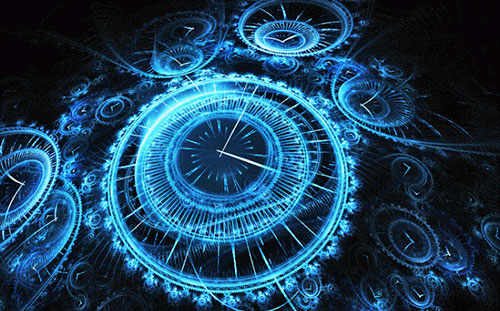|
by Deepak Chopra and Jordan Flesher March-April 2015
from
Collective-Evolution Website
March 31, 2015
For any experience, there must be a physical activity in the brain - otherwise, the experience has no basis.
Using this irrefutable assumption, researchers have looked for the seat of anger, criminal behavior, gender identification, the sense of self, and many other aspects of human nature. This includes spirituality.
Where is God in the brain? To many neuroscientists,
that's not only a valid question but the only one worth asking,
insofar as spiritual experiences have any reality.
Where the brain operates only in the present, genetics peers deep into the past. A geneticist would want to know what evolutionary advantage early humans got from being spiritual - in the broadest sense of the word - that led to a better chance to survive.
This whole line of inquiry, whether we're taking about the brain or our genes, makes sense if you are a materialist.
But it runs the danger of saying that spirituality is
only about the physical side of the experience, as if music could
never be discussed except by looking at pianos and radios, the
physical side of delivering the musical experience.
To explore
a new kind of explanation that embraces both the physical and
non-physical, let's examine an experience that most people have had.
Without experiencing God, angels, the soul, or other traditionally
religious things, almost everyone has had at least one or two
inexplicable coincidences in their lives.
Synchronicity doesn't feel random, which is how it is differentiated from coincidences that have no meaning but happen by chance.
The spiritual link involves how to explain a meaningful coincidence.
Events without causes lead to all kinds of unusual
explanations.
He first publically discussed synchronicity in a short essay describing synchronicity as an "acausal connecting principle." By using the word acausal he is pointing to the non-local nature of synchronicity.
Non-locality in quantum physics is one of its major principles.
Non-locality refers to behavior between particles
that doesn't need a specific cause or location in space-time.
Hitting a billiard ball with a cue entails both a cause and a
location. The location is the point where the tip of the cue strikes
the ball. The force of the strike is the cause that moves the ball.
Action at a distance has been popularly explained as,
Two particles that mirror each other's behavior are said to be entangled, although the mechanism behind action at a distance is unknown.
Entanglement fits the mathematical model underlying
quantum mechanics, and that is what counts when physics is arriving
at reliable, precise calculations.
Finding meaning in our lives, from any source, is essential.
So how can we fit synchronicity into a broader context? The key is to connect inner and outer, because synchronicity is about an event "out there" that has sudden meaning "in here."
To make the connection, nine principles apply to genuinely synchronous coincidences.
Taken together, these principles enable us to receive clues about the essential unity of two realities that seem to be separate:
The inner and outer are the same field, one non-dual consciousness that simultaneously creates both the subjective world and the objective world. Therefore, synchronicity isn't simply a passing anomaly that can be shrugged off.
Something crucial is happening...
It's spooky that the outside world can be
synchronized with our inner world, yet the bigger question is about
reality itself. Synchronicity, the common term for meaningful
coincidences, doesn't tend to change anyone's life - but it could.
Let's see how far the trail of clues takes us.
Two particles separated by light years can react immediately to changes of state in one of the pairs, so that Part A somehow "knows" what is happening to particle B instantaneously, without any visible connection.
This phenomenon, known as non-locality, is verified
physics even though it cannot be explained, only calculated as a key
aspect of highly complex equations.
For example, when highly successful people are asked about how they achieved their success, they often say that they were somehow the right person in the right place, not once or twice, but throughout their careers.
If they are religious, they say,
Luck is often invoked, but the one thing you almost never hear is that their success was random.
There's a wide gap between the meaning we experience in our lives and the randomness of scientific explanations. It goes beyond a single instance of synchronicity when many things fall together perfectly, as if being in sync overrides the ordinary notion of cause and effect.
When the link between inner and outer is strong enough, intuition strikes so deeply that the world of appearances turns transparent, revealing an underlying structure that is perfectly organized.
The unity experiences, which have occurred in every
culture, gave rise to the world's wisdom traditions. From that
perspective the tables are turned, and what are anomalous are random
events.
Seeing the universe as mind first and matter second
is the position of every spiritual tradition; introducing God is
actually secondary, in that some traditions accept the three
principles without needing a personal God to personify them.
...and the other qualities essential to consciousness.
Human beings didn't invent or imagine these
qualities. We possess them by drawing on an infinite reservoir -
in this way, without introducing religion, we understand why
omniscience, omnipotence, and omnipresence are undeniable features
of an all-pervading consciousness that pervades the cosmos.
There are three principles at work here, too.
These principles are obviously at work in human evolution, because the brain of Homo sapiens is the most complex entity on the evolutionary ladder.
Its complexity serves a purpose, to organize the
nearly infinite synchronicity that binds billions of neurons and
trillions of other cells into a wholeness. And this wholeness,
having transcended physiological functions common to all higher life
forms (e.g., digestion, respiration, reproduction, healing) focuses
its energies on consciousness itself.
Unable to see with our eyes the incredible
synchronicity that binds trillions of cells at every moment of life,
we need outer reflections to remind us that the invisible forces
holding reality together are constantly present, upholding the
highest stage of evolution that exists today, while preparing the
foundation for our next evolutionary step.
April 14, 2015
Two views of the universe have been contending with each other to explain why human beings exist.
The first view holds that human beings are not special in any way. We evolved through random events that have accumulated over time, taking 13.7 billion years since the big Bang to arrive at the most complex structure in creation, the human brain.
This view, long established in physics and biology,
constructs evolution in the absence of mind. Matter came first, and
mind emerged very late in the game.
Using our self-awareness, humans recognize,
...and the other qualities essential to consciousness.
Over the course of our evolution as a species, we have come to embody these qualities.
Therefore, the link between humanity and the universe
is intimate, to the extent that the only creation we experience is
the human cosmos.
Working from the other worldview, the eminent British
physicist Sir Roger Penrose has theorized that mathematics,
the essential language of science, is imbued by a Platonic value
like harmony and symmetry - these attributes give
mathematics its internal beauty, recognized by every great
mathematician and yet inexplicable if you attempt to break this
harmony down into reductionist bits of information.
Why, then, is there any disagreement about the compatibility of the subjective and objective approaches? The most obvious answer is habit and tradition.
The scientific viewpoint has been centered on
materialism,
Darwinian evolution, randomness,
and the exclusion of subjectivity for a long time.
The most reliable aspects are as follows:
These seven points are unarguable.
Human beings didnít invent or imagine them. They
arise from simple logic, and they pertain to any worldview,
including the religious and mystical. Attributing creation to God
or to the Big Bang is logically consistent within its own framework
and logically flawed outside that framework.
An origins story about life is just that, a story. Similarly, a brain scan can tell you about the firing of neurons in specific areas of the brain, such as the visual cortex.
But it says nothing about how the total darkness
inside the brain produces the sensation of light and color.
A reasonable definition of "everything" would also
have to include human experience - the search for theories, after
all, is itself an experience. But the Theory of Everything excludes
human experience, and therefore constitutes an extremely limited
definition of wholeness.
Yet the human brain isnít an adequate instrument for
understanding how every element was coordinated, either by chance or
by some unseen consciousness, to arrive at where we are in our
evolution.
Stapp recalls that in private conversation, Heisenberg believed for his mathematical framework to make sense, there needed to be what he called an "Objective-Mind". Such a mind orchestrates the cosmos, which is how objective observation suggests so strongly that behind the appearance of random events, reality is self-organizing, purposeful, and continuously evolving.
By analogy, if Rembrandt were invisible, an outside
observer would see his brush dip randomly into a palette of colors,
and yet the picture being produced assumes definite form, shape, and
meaning.
In other words, the facts collected by science are at the same time subjectively experienced.
The "mind of God" has cropped up in scientific discourse form time to time - Einstein used the phrase - as something more than a metaphor but less than a proven fact.
It points to a source of infinite potential from
which the universe draws its orderliness and at the same time the
human mind is able to recognize such orderliness.
Which viewpoint should people hold to in their daily lives...?
|



